Abstract
Few environmental compounds have generated as much interest and controversy within the scientific community and in the lay public as polychlorinated dibenzo-p-dioxins (PCDDs) and polychlorinated dibenzofurans (PCDFs). Their ubiquitous presence in the environment and the risk of accidental exposure has raised concern over a possible threat of PCDDs or PCDFs to human health. The most extensively studied and potent isomer is 2,3,7,8-tetrachlorodibenzo-p-dioxin (TCDD or dioxin). Dioxin is a multisite toxicant in laboratory rodents resulting in a number of tissue-, species-, and sex-dependent responses. Much has been learned about the mechanism of dioxin's effects, especially for the induction of cytochrome P-450 enzymes. Binding of PCDDs and PCDFs to a receptor protein, termed the dioxin or Ah receptor, is necessary for most biological and toxic responses. The most common toxic response used for evaluating the human health risk posed by PCDDs and PCDFs is the hepatocarcinogenic response observed primarily in rodents. Despite extensive research efforts, the effects of PCDDs and PCDFs on humans are not well characterized. However, available data indicate there is good agreement between known effects of dioxin in laboratory animals and those described in epidemiological studies for effects in humans. The sequence in events initiated by the Ah receptor interacting with dioxin-responsive genes and ending with altered patterns of differentiation and growth must be sought in order to understand tissue, species, sex, and interindividual variation in biological responses and the health risk posed by PCDDs and PCDFs.
Full text
PDF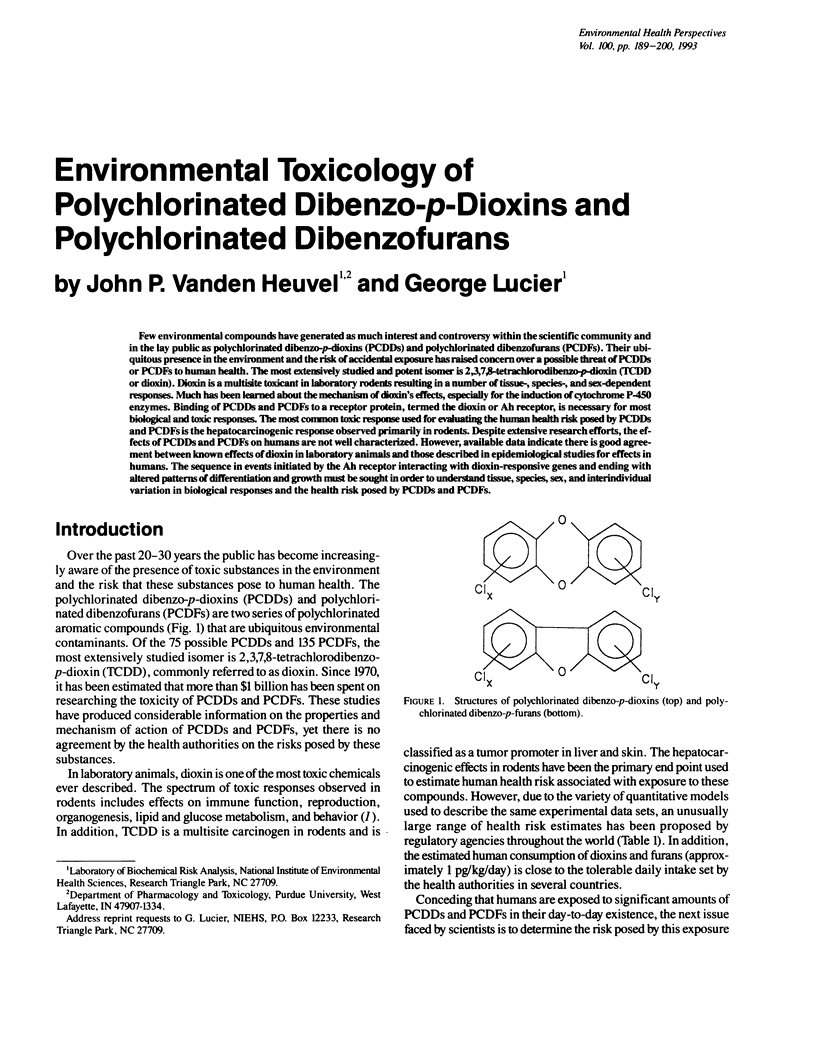
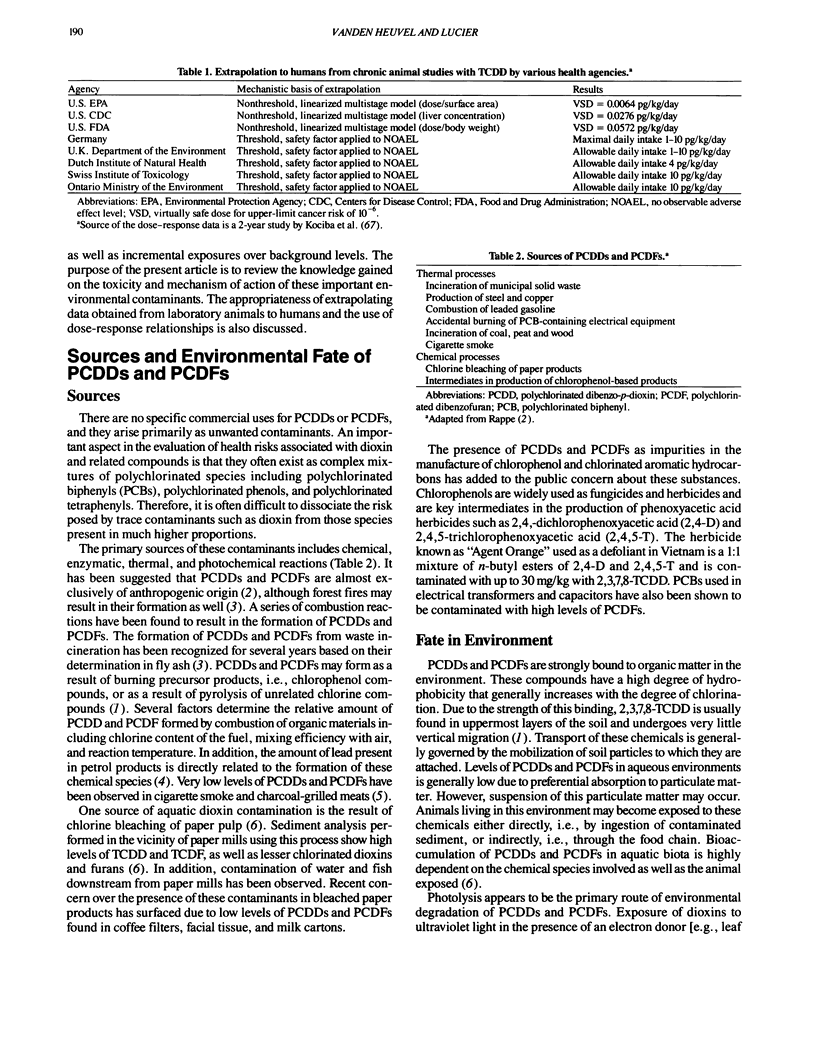

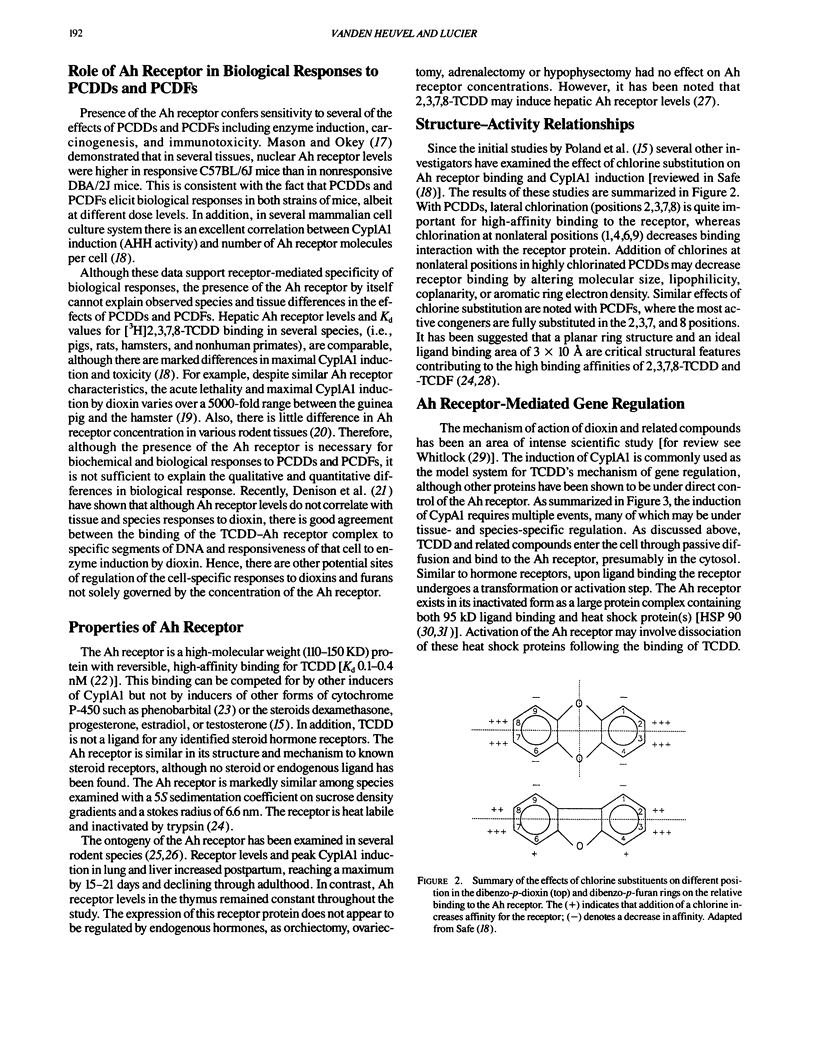
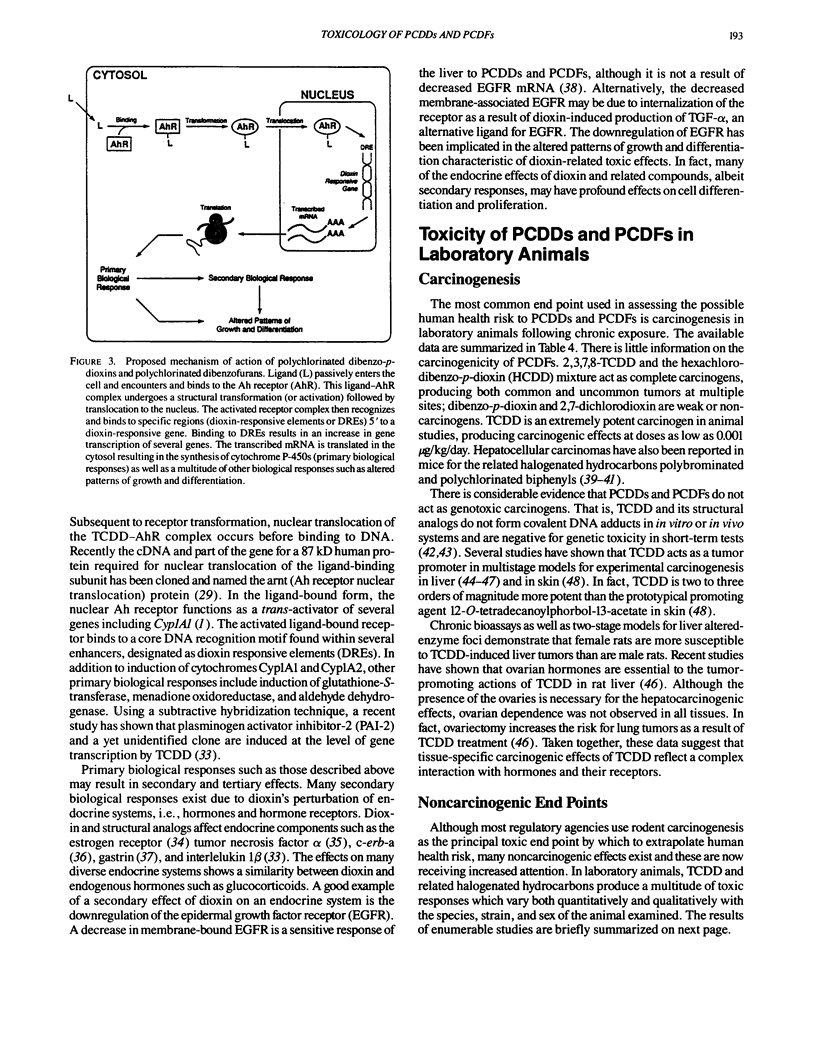
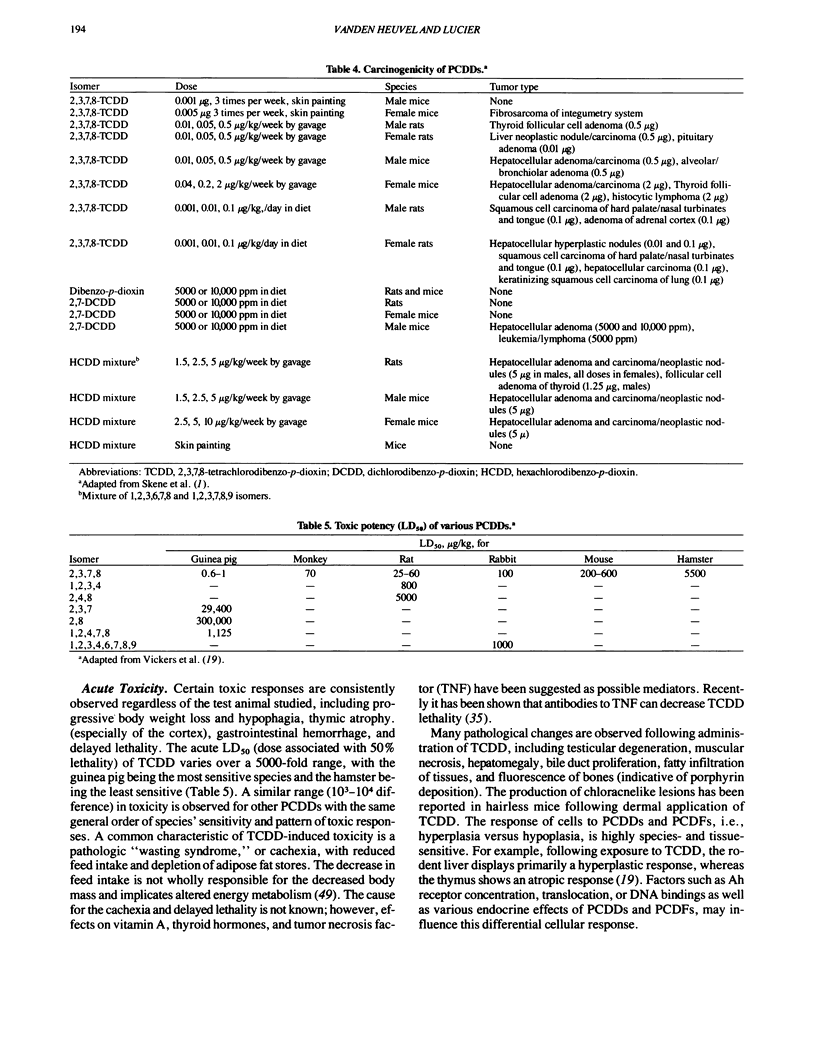
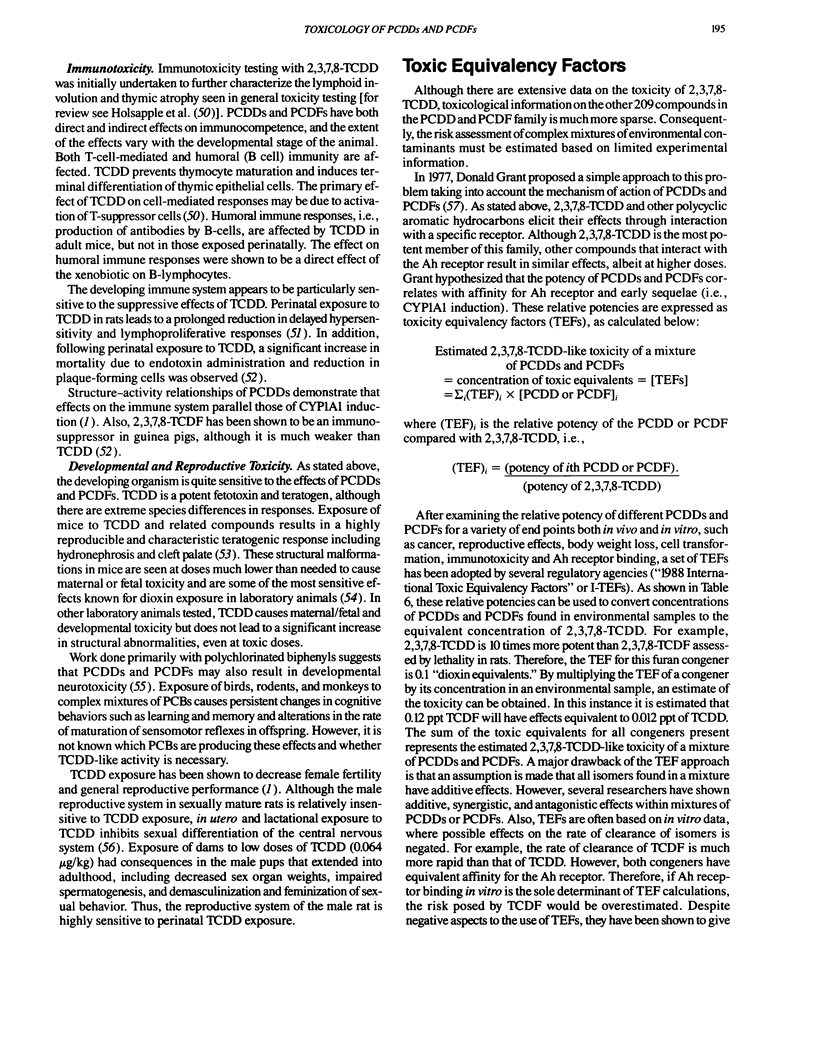
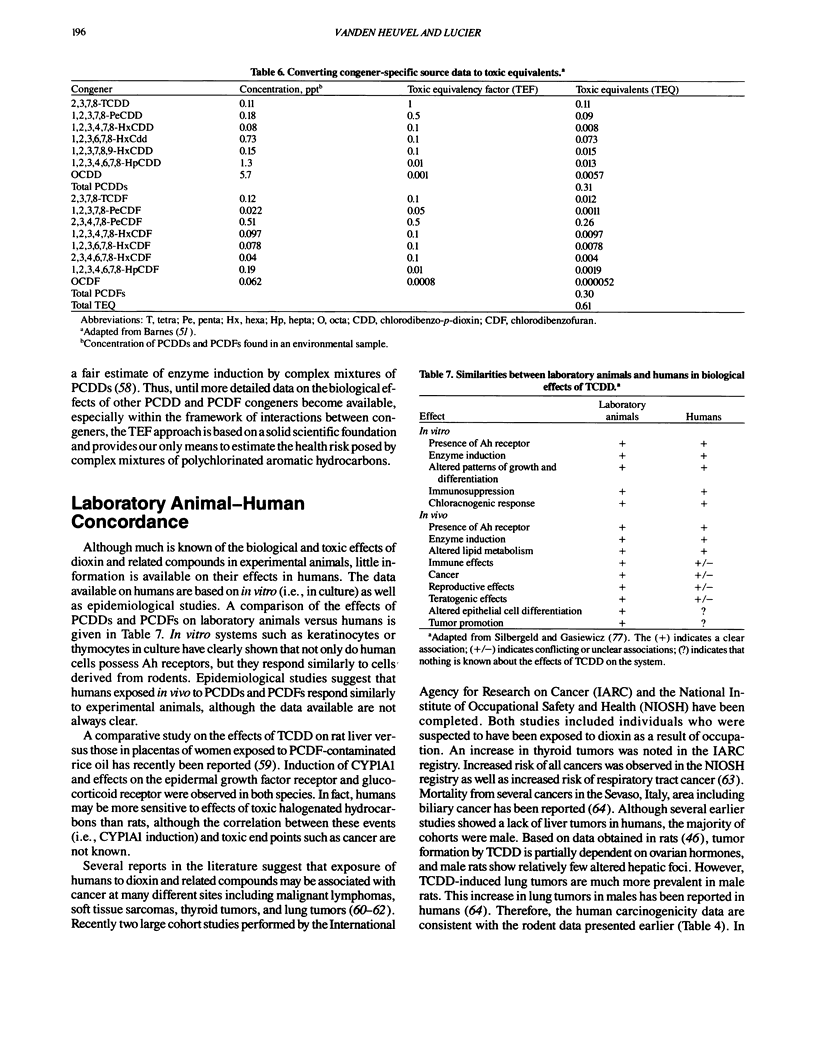
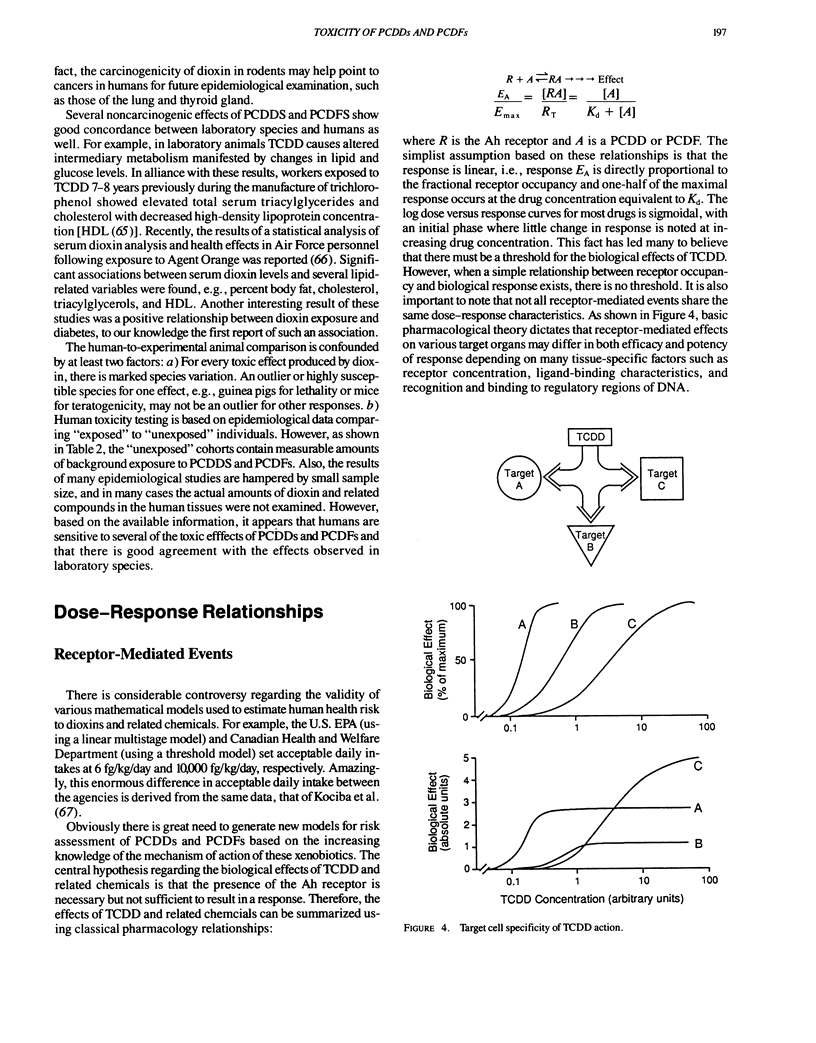
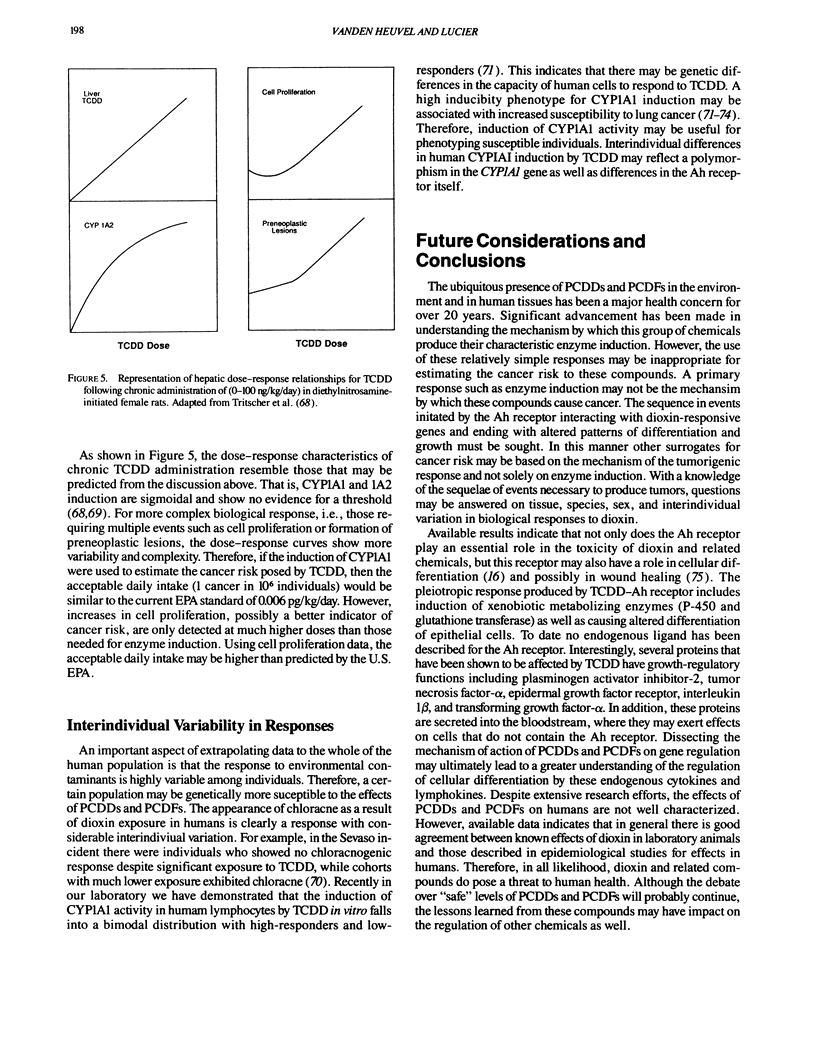
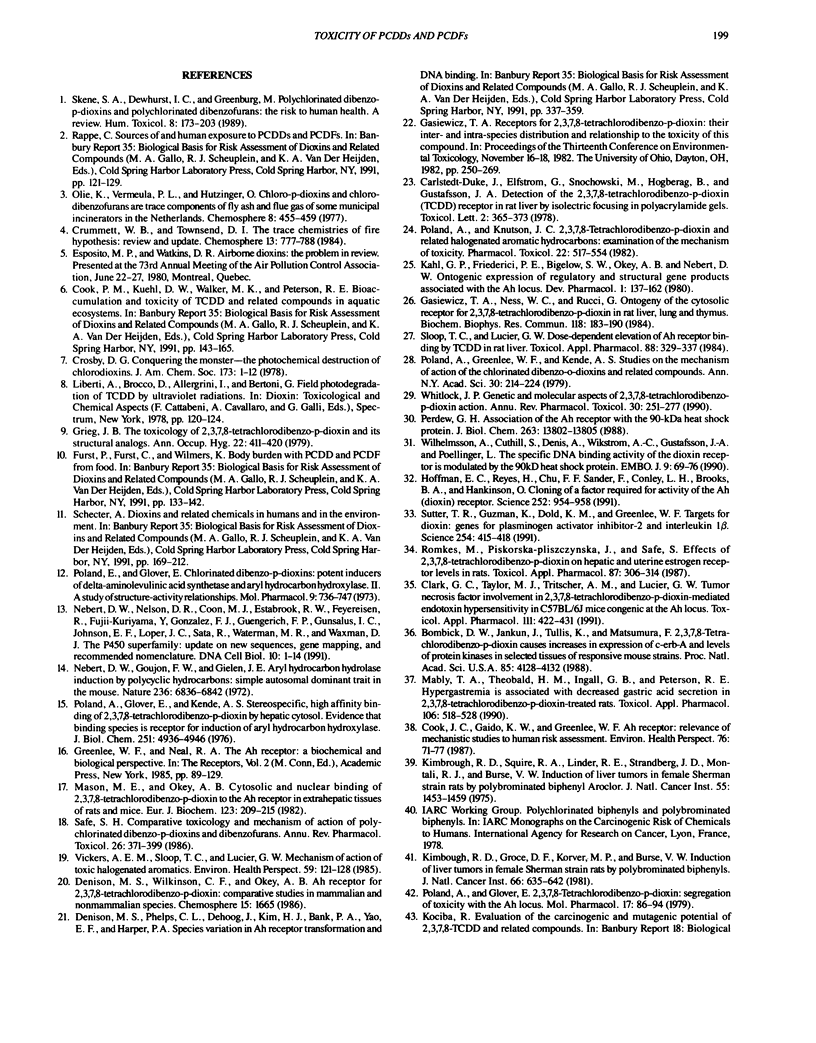
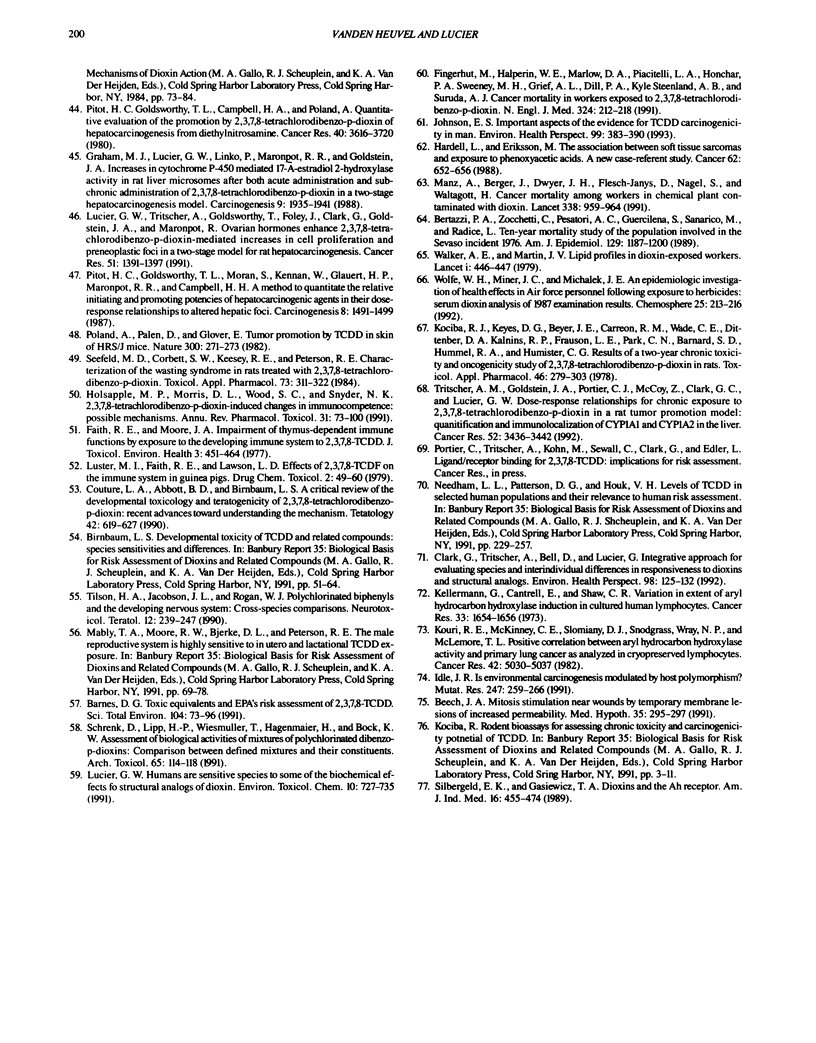
Selected References
These references are in PubMed. This may not be the complete list of references from this article.
- Barnes D. G. Toxicity equivalents and EPA's risk assessment of 2,3,7,8-TCDD. Sci Total Environ. 1991 May 1;104(1-2):73–86. doi: 10.1016/0048-9697(91)90008-3. [DOI] [PubMed] [Google Scholar]
- Beech J. A. Mitosis stimulation near wounds by temporary membrane lesions of increased permeability. Med Hypotheses. 1991 Aug;35(4):295–297. doi: 10.1016/0306-9877(91)90271-y. [DOI] [PubMed] [Google Scholar]
- Bertazzi P. A., Zocchetti C., Pesatori A. C., Guercilena S., Sanarico M., Radice L. Ten-year mortality study of the population involved in the Seveso incident in 1976. Am J Epidemiol. 1989 Jun;129(6):1187–1200. doi: 10.1093/oxfordjournals.aje.a115240. [DOI] [PubMed] [Google Scholar]
- Bombick D. W., Jankun J., Tullis K., Matsumura F. 2,3,7,8-Tetrachlorodibenzo-p-dioxin causes increases in expression of c-erb-A and levels of protein-tyrosine kinases in selected tissues of responsive mouse strains. Proc Natl Acad Sci U S A. 1988 Jun;85(12):4128–4132. doi: 10.1073/pnas.85.12.4128. [DOI] [PMC free article] [PubMed] [Google Scholar]
- Clark G. C., Taylor M. J., Tritscher A. M., Lucier G. W. Tumor necrosis factor involvement in 2,3,7,8-tetrachlorodibenzo-p-dioxin-mediated endotoxin hypersensitivity in C57BL/6J mice congenic at the Ah locus. Toxicol Appl Pharmacol. 1991 Dec;111(3):422–431. doi: 10.1016/0041-008x(91)90247-c. [DOI] [PubMed] [Google Scholar]
- Clark G., Tritscher A., Bell D., Lucier G. Integrated approach for evaluating species and interindividual differences in responsiveness to dioxins and structural analogs. Environ Health Perspect. 1992 Nov;98:125–132. doi: 10.1289/ehp.9298125. [DOI] [PMC free article] [PubMed] [Google Scholar]
- Cook J. C., Gaido K. W., Greenlee W. F. Ah receptor: relevance of mechanistic studies to human risk assessment. Environ Health Perspect. 1987 Dec;76:71–77. doi: 10.1289/ehp.877671. [DOI] [PMC free article] [PubMed] [Google Scholar]
- Couture L. A., Abbott B. D., Birnbaum L. S. A critical review of the developmental toxicity and teratogenicity of 2,3,7,8-tetrachlorodibenzo-p-dioxin: recent advances toward understanding the mechanism. Teratology. 1990 Dec;42(6):619–627. doi: 10.1002/tera.1420420606. [DOI] [PubMed] [Google Scholar]
- Faith R. E., Moore J. A. Impairment of thymus-dependent immune functions by exposure of the developing immune system to 2,3,7,8-tetrachlorodibenzo-p-dioxin (TCDD). J Toxicol Environ Health. 1977 Oct;3(3):451–464. doi: 10.1080/15287397709529578. [DOI] [PubMed] [Google Scholar]
- Fingerhut M. A., Halperin W. E., Marlow D. A., Piacitelli L. A., Honchar P. A., Sweeney M. H., Greife A. L., Dill P. A., Steenland K., Suruda A. J. Cancer mortality in workers exposed to 2,3,7,8-tetrachlorodibenzo-p-dioxin. N Engl J Med. 1991 Jan 24;324(4):212–218. doi: 10.1056/NEJM199101243240402. [DOI] [PubMed] [Google Scholar]
- Gasiewicz T. A., Ness W. C., Rucci G. Ontogeny of the cytosolic receptor for 2,3,7,8-tetrachlorodibenzo-p-dioxin in rat liver, lung, and thymus. Biochem Biophys Res Commun. 1984 Jan 13;118(1):183–190. doi: 10.1016/0006-291x(84)91084-2. [DOI] [PubMed] [Google Scholar]
- Graham M. J., Lucier G. W., Linko P., Maronpot R. R., Goldstein J. A. Increases in cytochrome P-450 mediated 17 beta-estradiol 2-hydroxylase activity in rat liver microsomes after both acute administration and subchronic administration of 2,3,7,8-tetrachlorodibenzo-p-dioxin in a two-stage hepatocarcinogenesis model. Carcinogenesis. 1988 Nov;9(11):1935–1941. doi: 10.1093/carcin/9.11.1935. [DOI] [PubMed] [Google Scholar]
- Greig J. B. The toxicology of 2,3,7,8-tetrachlorodibenzo-p-dioxin and its structural analogues. Ann Occup Hyg. 1979;22(4):411–420. doi: 10.1093/annhyg/22.4.411. [DOI] [PubMed] [Google Scholar]
- Hardell L., Eriksson M. The association between soft tissue sarcomas and exposure to phenoxyacetic acids. A new case-referent study. Cancer. 1988 Aug 1;62(3):652–656. doi: 10.1002/1097-0142(19880801)62:3<652::aid-cncr2820620334>3.0.co;2-4. [DOI] [PubMed] [Google Scholar]
- Hoffman E. C., Reyes H., Chu F. F., Sander F., Conley L. H., Brooks B. A., Hankinson O. Cloning of a factor required for activity of the Ah (dioxin) receptor. Science. 1991 May 17;252(5008):954–958. doi: 10.1126/science.1852076. [DOI] [PubMed] [Google Scholar]
- Holsapple M. P., Morris D. L., Wood S. C., Snyder N. K. 2,3,7,8-tetrachlorodibenzo-p-dioxin-induced changes in immunocompetence: possible mechanisms. Annu Rev Pharmacol Toxicol. 1991;31:73–100. doi: 10.1146/annurev.pa.31.040191.000445. [DOI] [PubMed] [Google Scholar]
- Idle J. R. Is environmental carcinogenesis modulated by host polymorphism? Mutat Res. 1991 Apr;247(2):259–266. doi: 10.1016/0027-5107(91)90021-f. [DOI] [PubMed] [Google Scholar]
- Johnson E. S. Important aspects of the evidence for TCDD carcinogenicity in man. Environ Health Perspect. 1993 Mar;99:383–390. doi: 10.1289/ehp.9399383. [DOI] [PMC free article] [PubMed] [Google Scholar]
- Kahl G. F., Friederici D. E., Bigelow S. W., Okey A. B., Nebert D. W. Ontogenetic expression of regulatory and structural gene products associated with the Ah locus. Comparison of rat, mouse, rabbit and Sigmoden hispedis. Dev Pharmacol Ther. 1980;1(2-3):137–162. [PubMed] [Google Scholar]
- Kellermann G., Cantrell E., Shaw C. R. Variations in extent of aryl hydrocarbon hydroxylase induction in cultured human lymphocytes. Cancer Res. 1973 Jul;33(7):1654–1656. [PubMed] [Google Scholar]
- Kimbrough R. D., Squire R. A., Linder R. E., Strandberg J. D., Montalli R. J., Burse V. W. Induction of liver tumor in Sherman strain female rats by polychlorinated biphenyl aroclor 1260. J Natl Cancer Inst. 1975 Dec;55(6):1453–1459. doi: 10.1093/jnci/55.6.1453. [DOI] [PubMed] [Google Scholar]
- Kociba R. J., Keyes D. G., Beyer J. E., Carreon R. M., Wade C. E., Dittenber D. A., Kalnins R. P., Frauson L. E., Park C. N., Barnard S. D. Results of a two-year chronic toxicity and oncogenicity study of 2,3,7,8-tetrachlorodibenzo-p-dioxin in rats. Toxicol Appl Pharmacol. 1978 Nov;46(2):279–303. doi: 10.1016/0041-008x(78)90075-3. [DOI] [PubMed] [Google Scholar]
- Kouri R. E., McKinney C. E., Slomiany D. J., Snodgrass D. R., Wray N. P., McLemore T. L. Positive correlation between high aryl hydrocarbon hydroxylase activity and primary lung cancer as analyzed in cryopreserved lymphocytes. Cancer Res. 1982 Dec;42(12):5030–5037. [PubMed] [Google Scholar]
- Lucier G. W., Tritscher A., Goldsworthy T., Foley J., Clark G., Goldstein J., Maronpot R. Ovarian hormones enhance 2,3,7,8-tetrachlorodibenzo-p-dioxin-mediated increases in cell proliferation and preneoplastic foci in a two-stage model for rat hepatocarcinogenesis. Cancer Res. 1991 Mar 1;51(5):1391–1397. [PubMed] [Google Scholar]
- Luster M. I., Faith R. E., Lawson L. D. Effects of 2,3,7,8-tetrachlorodibenzofuran (TCDF) on the immune system in guinea pigs. Drug Chem Toxicol. 1979;2(1-2):49–60. doi: 10.3109/01480547908993181. [DOI] [PubMed] [Google Scholar]
- Mably T. A., Theobald H. M., Ingall G. B., Peterson R. E. Hypergastrinemia is associated with decreased gastric acid secretion in 2,3,7,8-tetrachlorodibenzo-p-dioxin-treated rats. Toxicol Appl Pharmacol. 1990 Dec;106(3):518–528. doi: 10.1016/0041-008x(90)90346-v. [DOI] [PubMed] [Google Scholar]
- Manz A., Berger J., Dwyer J. H., Flesch-Janys D., Nagel S., Waltsgott H. Cancer mortality among workers in chemical plant contaminated with dioxin. Lancet. 1991 Oct 19;338(8773):959–964. doi: 10.1016/0140-6736(91)91835-i. [DOI] [PubMed] [Google Scholar]
- Mason M. E., Okey A. B. Cytosolic and nuclear binding of 2,3,7,8-tetrachlorodibenzo-p-dioxin to the Ah receptor in extra-hepatic tissues of rats and mice. Eur J Biochem. 1982 Mar;123(1):209–215. doi: 10.1111/j.1432-1033.1982.tb06518.x. [DOI] [PubMed] [Google Scholar]
- Nebert D. W., Nelson D. R., Coon M. J., Estabrook R. W., Feyereisen R., Fujii-Kuriyama Y., Gonzalez F. J., Guengerich F. P., Gunsalus I. C., Johnson E. F. The P450 superfamily: update on new sequences, gene mapping, and recommended nomenclature. DNA Cell Biol. 1991 Jan-Feb;10(1):1–14. doi: 10.1089/dna.1991.10.1. [DOI] [PubMed] [Google Scholar]
- Perdew G. H. Association of the Ah receptor with the 90-kDa heat shock protein. J Biol Chem. 1988 Sep 25;263(27):13802–13805. [PubMed] [Google Scholar]
- Pitot H. C., Goldsworthy T. L., Moran S., Kennan W., Glauert H. P., Maronpot R. R., Campbell H. A. A method to quantitate the relative initiating and promoting potencies of hepatocarcinogenic agents in their dose-response relationships to altered hepatic foci. Carcinogenesis. 1987 Oct;8(10):1491–1499. doi: 10.1093/carcin/8.10.1491. [DOI] [PubMed] [Google Scholar]
- Pitot H. C., Goldsworthy T., Campbell H. A., Poland A. Quantitative evaluation of the promotion by 2,3,7,8-tetrachlorodibenzo-p-dioxin of hepatocarcinogenesis from diethylnitrosamine. Cancer Res. 1980 Oct;40(10):3616–3620. [PubMed] [Google Scholar]
- Poland A., Glover E. 2,3,7,8,-Tetrachlorodibenzo-p-dioxin: segregation of toxocity with the Ah locus. Mol Pharmacol. 1980 Jan;17(1):86–94. [PubMed] [Google Scholar]
- Poland A., Glover E. Chlorinated dibenzo-p-dioxins: potent inducers of delta-aminolevulinic acid synthetase and aryl hydrocarbon hydroxylase. II. A study of the structure-activity relationship. Mol Pharmacol. 1973 Nov;9(6):736–747. [PubMed] [Google Scholar]
- Poland A., Glover E., Kende A. S. Stereospecific, high affinity binding of 2,3,7,8-tetrachlorodibenzo-p-dioxin by hepatic cytosol. Evidence that the binding species is receptor for induction of aryl hydrocarbon hydroxylase. J Biol Chem. 1976 Aug 25;251(16):4936–4946. [PubMed] [Google Scholar]
- Poland A., Knutson J. C. 2,3,7,8-tetrachlorodibenzo-p-dioxin and related halogenated aromatic hydrocarbons: examination of the mechanism of toxicity. Annu Rev Pharmacol Toxicol. 1982;22:517–554. doi: 10.1146/annurev.pa.22.040182.002505. [DOI] [PubMed] [Google Scholar]
- Poland A., Palen D., Glover E. Tumour promotion by TCDD in skin of HRS/J hairless mice. Nature. 1982 Nov 18;300(5889):271–273. doi: 10.1038/300271a0. [DOI] [PubMed] [Google Scholar]
- Romkes M., Piskorska-Pliszczynska J., Safe S. Effects of 2,3,7,8-tetrachlorodibenzo-p-dioxin on hepatic and uterine estrogen receptor levels in rats. Toxicol Appl Pharmacol. 1987 Feb;87(2):306–314. doi: 10.1016/0041-008x(87)90292-4. [DOI] [PubMed] [Google Scholar]
- Safe S. H. Comparative toxicology and mechanism of action of polychlorinated dibenzo-p-dioxins and dibenzofurans. Annu Rev Pharmacol Toxicol. 1986;26:371–399. doi: 10.1146/annurev.pa.26.040186.002103. [DOI] [PubMed] [Google Scholar]
- Schrenk D., Lipp H. P., Wiesmüller T., Hagenmaier H., Bock K. W. Assessment of biological activities of mixtures of polychlorinated dibenzo-p-dioxins: comparison between defined mixtures and their constituents. Arch Toxicol. 1991;65(2):114–118. doi: 10.1007/BF02034936. [DOI] [PubMed] [Google Scholar]
- Seefeld M. D., Corbett S. W., Keesey R. E., Peterson R. E. Characterization of the wasting syndrome in rats treated with 2,3,7,8-tetrachlorodibenzo-p-dioxin. Toxicol Appl Pharmacol. 1984 Apr;73(2):311–322. doi: 10.1016/0041-008x(84)90337-5. [DOI] [PubMed] [Google Scholar]
- Silbergeld E. K., Gasiewicz T. A. Dioxins and the Ah receptor. Am J Ind Med. 1989;16(4):455–474. doi: 10.1002/ajim.4700160411. [DOI] [PubMed] [Google Scholar]
- Skene S. A., Dewhurst I. C., Greenberg M. Polychlorinated dibenzo-p-dioxins and polychlorinated dibenzofurans: the risks to human health. A review. Hum Toxicol. 1989 May;8(3):173–203. doi: 10.1177/096032718900800301. [DOI] [PubMed] [Google Scholar]
- Sloop T. C., Lucier G. W. Dose-dependent elevation of Ah receptor binding by TCDD in rat liver. Toxicol Appl Pharmacol. 1987 May;88(3):329–337. doi: 10.1016/0041-008x(87)90208-0. [DOI] [PubMed] [Google Scholar]
- Sutter T. R., Guzman K., Dold K. M., Greenlee W. F. Targets for dioxin: genes for plasminogen activator inhibitor-2 and interleukin-1 beta. Science. 1991 Oct 18;254(5030):415–418. doi: 10.1126/science.1925598. [DOI] [PubMed] [Google Scholar]
- Tilson H. A., Jacobson J. L., Rogan W. J. Polychlorinated biphenyls and the developing nervous system: cross-species comparisons. Neurotoxicol Teratol. 1990 May-Jun;12(3):239–248. doi: 10.1016/0892-0362(90)90095-t. [DOI] [PubMed] [Google Scholar]
- Tritscher A. M., Goldstein J. A., Portier C. J., McCoy Z., Clark G. C., Lucier G. W. Dose-response relationships for chronic exposure to 2,3,7,8-tetrachlorodibenzo-p-dioxin in a rat tumor promotion model: quantification and immunolocalization of CYP1A1 and CYP1A2 in the liver. Cancer Res. 1992 Jun 15;52(12):3436–3442. [PubMed] [Google Scholar]
- Vickers A. E., Sloop T. C., Lucier G. W. Mechanism of action of toxic halogenated aromatics. Environ Health Perspect. 1985 Feb;59:121–128. doi: 10.1289/ehp.59-1568090. [DOI] [PMC free article] [PubMed] [Google Scholar]
- Walker A. E., Martin J. V. Lipid profiles in dioxin-exposed workers. Lancet. 1979 Feb 24;1(8113):446–447. doi: 10.1016/s0140-6736(79)90929-2. [DOI] [PubMed] [Google Scholar]
- Whitlock J. P., Jr Genetic and molecular aspects of 2,3,7,8-tetrachlorodibenzo-p-dioxin action. Annu Rev Pharmacol Toxicol. 1990;30:251–277. doi: 10.1146/annurev.pa.30.040190.001343. [DOI] [PubMed] [Google Scholar]
- Wilhelmsson A., Cuthill S., Denis M., Wikström A. C., Gustafsson J. A., Poellinger L. The specific DNA binding activity of the dioxin receptor is modulated by the 90 kd heat shock protein. EMBO J. 1990 Jan;9(1):69–76. doi: 10.1002/j.1460-2075.1990.tb08081.x. [DOI] [PMC free article] [PubMed] [Google Scholar]


